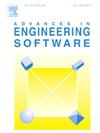利用计算机视觉和机器学习对钢筋混凝土剪力墙进行多特征地震破坏状态识别
IF 4
2区 工程技术
Q2 COMPUTER SCIENCE, INTERDISCIPLINARY APPLICATIONS
引用次数: 0
摘要
本文采用机器学习算法,开发了一种基于图像的方法,用于矩形钢筋混凝土剪力墙的地震诱发损伤状态预测。机器学习模型的开发使用了一个数据库,其中包括从文献中收集的 285 幅受损钢筋混凝土剪力墙表面裂缝图的实验数据点。八种不同的机器学习算法被用来训练损伤等级分类模型。损坏等级是根据 FEMA P-58 损坏类别定义的。除了矩形截面钢筋混凝土剪力墙的结构和几何属性外,还测量了三个基于图像的指数,包括琥珀度(Succolarity)、漆度(Lacunarity)和广义分形维度(generalized fractal dimensions),作为预测模型的输入特征。选择了九组特征作为机器学习算法的输入。使用 GridsearchCV 函数,从一组可能的参数中选择出算法性能最佳的超参数。采用五倍交叉验证技术,通过重采样程序对模型进行评估。结果表明,使用极端梯度提升(XGB)算法的预测模型,其输入包括结构参数和图像指数,在防止过拟合和分类准确性方面表现最佳。损伤状态识别的结果可用于钢筋混凝土建筑的安全评估以及地震后的维修/拆除决策。本文章由计算机程序翻译,如有差异,请以英文原文为准。
Multi-feature driven seismic damage state identification for reinforced concrete shear walls using computer vision and machine learning
In this paper, an image-based methodology using machine learning algorithms is developed for earthquake-induced damage state prediction in rectangular reinforced concrete shear walls. The machine learning models are developed using a database including experimental data points of 285 surface crack maps of damaged reinforced concrete shear walls collected from the literature. Eight different machine learning algorithms are utilized to train the damage-level classification models. The damage levels are defined according to the FEMA P-58 damage categories. In addition to the structural and geometric properties of the reinforced concrete shear walls with rectangular cross-section, three image-based indices including Succolarity, Lacunarity, and generalized fractal dimensions are measured as input features of the predictive models. Nine groups of features are selected as input for the machine learning algorithms. Using the GridsearchCV function, the hyperparameters resulting in the best algorithmic performance are chosen from a set of possible parameters. A five-fold cross-validation technique is applied to evaluate the models by resampling procedure. According to the results, the predictive model that uses the Extreme Gradient Boosting (XGB) algorithm with inputs that include both structural parameters and image indices performs best in terms of both overfitting prevention and classification accuracy. The outcomes of the damage state identification can be employed for safety assessment of the reinforced concrete buildings as well as repair/demolish decision-making after an earthquake.
求助全文
通过发布文献求助,成功后即可免费获取论文全文。
去求助
来源期刊

Advances in Engineering Software
工程技术-计算机:跨学科应用
CiteScore
7.70
自引率
4.20%
发文量
169
审稿时长
37 days
期刊介绍:
The objective of this journal is to communicate recent and projected advances in computer-based engineering techniques. The fields covered include mechanical, aerospace, civil and environmental engineering, with an emphasis on research and development leading to practical problem-solving.
The scope of the journal includes:
• Innovative computational strategies and numerical algorithms for large-scale engineering problems
• Analysis and simulation techniques and systems
• Model and mesh generation
• Control of the accuracy, stability and efficiency of computational process
• Exploitation of new computing environments (eg distributed hetergeneous and collaborative computing)
• Advanced visualization techniques, virtual environments and prototyping
• Applications of AI, knowledge-based systems, computational intelligence, including fuzzy logic, neural networks and evolutionary computations
• Application of object-oriented technology to engineering problems
• Intelligent human computer interfaces
• Design automation, multidisciplinary design and optimization
• CAD, CAE and integrated process and product development systems
• Quality and reliability.
 求助内容:
求助内容: 应助结果提醒方式:
应助结果提醒方式:


